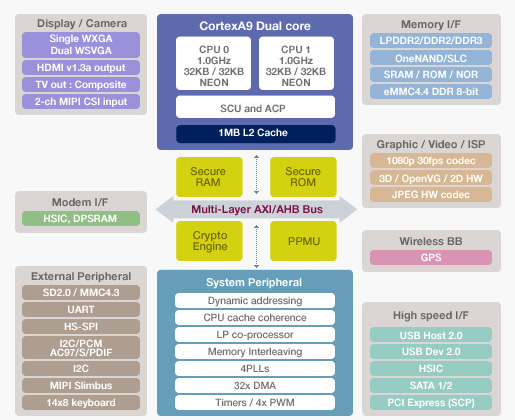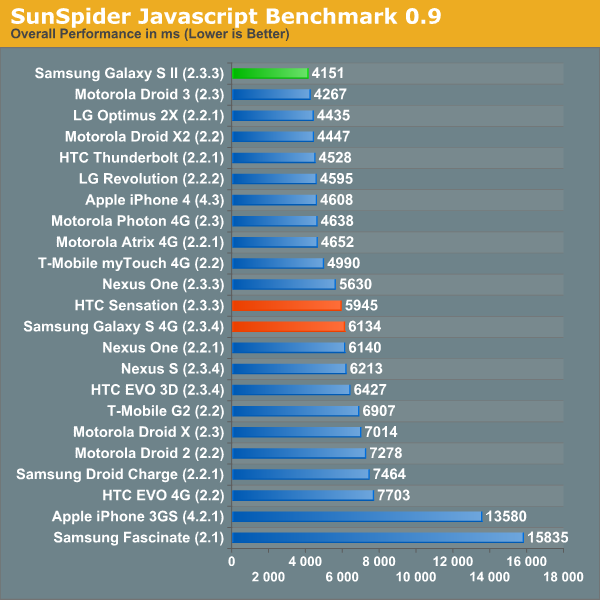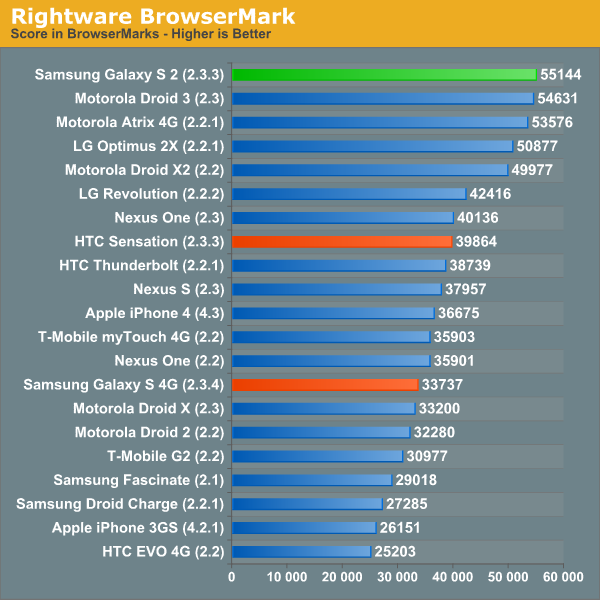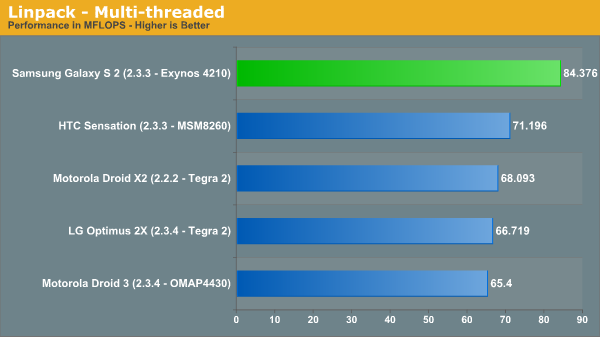Samsung Galaxy S 2 (International) Review - The Best, Redefined
by Brian Klug & Anand Lal Shimpi on September 11, 2011 11:06 AM EST- Posted in
- Smartphones
- Samsung
- Galaxy S II
- Exynos
- Mobile
The Fastest Smartphone SoC Today: Samsung Exynos 4210
Samsung has been Apple's sole application processor supplier since the release of the original iPhone. It's unclear how much Samsung contributes to the design process, especially with later SoCs like the A4 and A5 carrying the Apple brand. It's possible that Samsung is now no more than a manufacturing house for Apple.
Needless to say, the past few years of supplying SoCs for the iPhone and iPad have given Samsung a good idea of what the market wants from an application processor. We first got the hint that Samsung knew what it was up to with its Hummingbird SoC, used in the Galaxy S line of smartphones.
Hummingbird featured a 1GHz ARM Cortex A8 core and an Imagination Technologies PowerVR SGX 540 GPU. Although those specs don't seem very impressive today, Hummingbird helped Samsung ship more Android smartphones than any of its competitors in 2010. At a high level, Hummingbird looked a lot like Apple's A4 used in the iPad and iPhone 4. Its predecessor looked a lot like Apple's 3rd generation SoC used in the iPhone 3GS.
Hummingbird's successor however is Samsung's first attempt at something different. This is the Exynos 4210 application processor:

We first met the Exynos back when it was called Orion at this year's Mobile World Congress. Architecturally, the Exynos 4210 isn't too far from Apple's A5, NVIDIA's Tegra 2 or TI's OMAP 4. This is the same CPU configuration as all of the aforementioned SoCs, with a twist. While the A5, Tegra 2 and OMAP 4 all have a pair of ARM Cortex A9 cores running at 1GHz, Exynos pushes the default clock speed up to 1.2GHz. Samsung is able to hit higher clock speeds either through higher than normal voltages or as a result of its close foundry/design relationship.

Exynos 4210 with its PoP LPDDR2
ARM's Cortex A9 has configurable cache sizes. To date all of the A9 implementations we've seen use 32KB L1 caches (32KB instruction cache + 32KB data cache) and Samsung's Exynos is no exception. The L2 cache size is also configurable, however we haven't seen any variance there either. Apple, NVIDIA, Samsung and TI have all standardized on a full 1MB L2 cache shared between both cores. Only Qualcomm is left with a 512KB L2 cache but that's for a non-A9 design.

Where we have seen differences in A9 based SoCs are in the presence of ARM's Media Processing Engine (NEON SIMD unit) and memory controller configuration. Apple, Samsung and TI all include an MPE unit in each A9 core. ARM doesn't make MPE a requirement for the A9 since it has a fully pipelined FPU, however it's a good idea to include one given most A8 designs featured a similar unit. Without MPE support you run the risk of delivering an A9 based SoC that occasionally has lower performance than an A8 w/ NEON solution. Given that Apple, Samsung and TI all had NEON enabled A8 SoCs in the market last year, it's no surprise that their current A9 designs include MPE units.
NVIDIA on the other hand didn't have an SoC based on ARM's Cortex A8. At the same time it needed to be aggressive on pricing to gain some traction in the market. As a result of keeping die size to a minimum, the Tegra 2 doesn't include MPE support. NEON code can't be executed on Tegra 2. With Tegra 3 (Kal-El), NVIDIA added in MPE support but that's a discussion we'll have in a couple of months.
Although based on Qualcomm's own design, the Snapdragon cores include NEON support as well. Qualcomm's NEON engine is 128-bits wide vs. 64-bits wide in ARM's standard implementation. Samsung lists the Exynos 4210 as supporting both 64-bit and 128-bit NEON however given this is a seemingly standard A9 implementation I believe the MPE datapath is only 64-bits wide. In other words, 128-bit operations can be executed but not at the same throughput as 64-bit operations.
The same designs that implemented MPE also implemented a dual-channel memory controller. Samsung's Exynos features two 32-bit LPDDR2 memory channels, putting it on par with Apple's A5, Qualcomm's Snapdragon and TI's OMAP 4. Only NVIDIA's Tegra 2 features a single 32-bit LPDDR2 memory channel.
| ARM Cortex A9 Based SoC Comparison | ||||||
| Apple A5 | Samsung Exynos 4210 | TI OMAP 4 | NVIDIA Tegra 2 | |||
| Clock Speed | Up to 1GHz | Up to 1.2GHz | Up to 1GHz | Up to 1GHz | ||
| Core Count | 2 | 2 | 2 | 2 | ||
| L1 Cache Size | 32KB/32KB | 32KB/32KB | 32KB/32KB | 32KB/32KB | ||
| L2 Cache Size | 1MB | 1MB | 1MB | 1MB | ||
| Memory Interface | Dual Channel LP-DDR2 | Dual Channel LP-DDR2 | Dual Channel LP-DDR2 | Single Channel LP-DDR2 | ||
| NEON Support | Yes | Yes | Yes | No | ||
| Manufacturing Process | 45nm | 45nm | 45nm | 40nm | ||
Like most of its competitors, Samsung's memory controller does allow for some flexibility when choosing memory types. In addition to LPDDR2, the Exynos 4210 supports standard DDR2 and DDR3. Maximum data rate is limited to 800MHz regardless of memory type.
Based on everything I've said thus far, the Exynos 4210 should be among the highest performing SoCs on the market today. It has the same clock for clock performance as an Apple A5, NVIDIA Tegra 2 and TI OMAP 4430. Samsung surpassed those designs by delivering a 20% higher operating frequency, which should be tangible in typical use.
To find out let's turn to our CPU performance suite. We'll start with our browser benchmarks: SunSpider and BrowserMark:


Despite the 20% clock speed advantage the Galaxy S 2 isn't any faster than Motorola's Droid 3 based on a 1GHz TI OMAP 4430. Unfortunately this doesn't tell us too much since both benchmarks take into account browser performance as well as total platform performance. While the Galaxy S 2 is clearly among the fastest smartphones we've ever reviewed it looks like Motorola's browser may actually be a bit more efficient at javascript execution.
Where we do see big gains from the Exynos' higher clock speed is in our Linpack tests. The single-threaded benchmark actually shows more scaling than just clock speed, indicating that here are other (possibly software?) factors at play here. Either way it's clear that the 20% increase in clock speed can surface as tangible if the conditions are right:


A clock speed advantage today is nice but it's something that Samsung's competitors will be able to deliver in the not too distant future. Where Samsung chose to really differentiate itself was in the graphics department. The Exynos 4210 uses ARM's Mali-400 MP4 GPU.
Shipping in smartphones today we have GPUs from three vendors: Qualcomm (Adreno), Imagination Technologies (PowerVR SGX) and NVIDIA (GeForce). Of those vendors, only Qualcomm and NVIDIA produce SoCs - Imagination simply licenses its technology to SoC vendors.
Both Apple and Intel hold significant amounts of Imagination stock, presumably to protect against an eager SoC vendor from taking control of the company.
ARM also offers GPU IP in addition to its CPU designs, however we've seen very little uptake until now. Before we get to Mali's architecture, we need to talk a bit about the different types of GPUs on the market today.










132 Comments
View All Comments
numberoneoppa - Wednesday, September 14, 2011 - link
Guys, that mysterious notch you write about is not for straps, it's for phone charms, and it's arguably my favourite feature of samsung phones. (In korea, phone charms can be used for more than just cute things, one can get a T-money card that will hang here, or an apartment key).Tishyn - Wednesday, September 14, 2011 - link
I spend hours every week just browsing through reviews and tests comparing devices and vendors. This is one if the most interesting and most comprehensive review I've read for a veery long time.I especially enjoyed the rendering part and how it relates to the ultra mobile device market. Thumbs up!
milli - Wednesday, September 14, 2011 - link
Brian / Anand, why are you so reluctant to test chips from this company? ZiiO tablets, sporting the ZMS-08, are available for a while now and i'm sure Creative would send you the new Jaguar3 tablet (ZMS-20) if you guys would ask for it.The ZMS-20 has 26 GFlops ... faster than anything you've tested till now. The ZMS-40 coming in Q4 doubles that number!
I'm an old school IT technician and I for one don't understand your lack of interest. The GPU's in these chips are based on technology that Creative acquired with the 3DLabs purchase.
rigel84 - Thursday, September 15, 2011 - link
Just a quick tip: You can take a screenshot by pressing the power and home button at the same time.If you double tap your home button it will bring the voice talk feature.
While watching video clips just press the power button to disable the touch sensitive buttons.
Swipe your finger to the left on contact name to send him a message
Swipe you finger to the right on the contact name to dial the contact.
To see all the tabs in the browser just pinch inside twice :)
If you experience random reboots when you drop it on the table, or if you are leaning towards things or running, then try to cut a piece of paper and put it under the battery. It happens because the battery shortly looses connection to the pins. If you check XDA you can see that many people has this problem, and I had it too. I was experiencing many random reboots whenever I had it in my pocket, but after I pit a piece of paper below the battery they all disappeared.
A few things...
- GPS is horrible if you ask me. Unless I download the data before with gps-status then it takes ages. Mostly 15-30 seconds with 2.3.3 (no idea if the radio got updated in the release)
- Kies AIR is HORRIBLE! It's on pair with realmedia's real player from 10 years ago. Crash on crash on crash and sluggish behavior.
- I don't know whether it's the phone or not, but I've been missing a lot of text messages after I got my Galaxy S2. I'm on the same net, but along with the poor GPS reception I'm suspectiong the phone :(
- There is a stupid 458 character limit on textmessages, and then they are auto-converted to an MMS message. There is a fixed mms.apk on XDA (requires root) or you can download something like Go SMS Pro (still free) on the market, which removes this stupid limit.
ph00ny - Thursday, September 15, 2011 - link
OddI haven't seen any posts about the battery disconnect issues and if you've been browsing the xda forum, probably saw my thread about dropping my phone on concrete twice...
As for Kies AIR, i've used it twice and my expectation was low to begin and it wasn't that bad. Some things were definitely slow but it's a good start
-GPS for me has always been solid. I even used it on multiple trips in less than ideal location, not a single glitch even with shoddy cell reception.
ciparis - Tuesday, September 27, 2011 - link
I've been using Sprint's SGS2 (Epic 4G) for less than a day, but already there are some annoying points which I'm surprised aren't mentioned in this review:1) The digitizer lags behind finger movement.
In the web browser, when your finger moves, there is a disconnected rubber-band effect before the screen catches up with your finger. This is visible in the browsing smoothness video as well, and it's very noticeable in actual use. Coming from an iPhone 4, it feels cheap and broken.
2) Back/Forward navigation often ignores the previous scroll point.
If you spend some amount of time reading a page you arrived at from a link (it seems to be about 10 seconds or so), hitting back doesn't take you back where you were previously reading from -- instead of returning you to the page position where the link was, it drops you at the top of the page. This makes real web usage tedious. On the Sprint, the timing seems to be related to when the 4G icon indicates sleep mode: hit back before the radio sleeps and you are returned to the right spot. In actual use, this rarely happens.
3) The browser resets the view to the top, even after you've started scrolling.
When loading a page, there's a point in which the page is visible and usable, but it's technically still loading (which can go on for quite a awhile, depending on the page). It's natural to start reading the page and scrolling down, but typically the phone will randomly jerk the scroll back up to the top of the page, sometimes several times before the page is done. This is unbelievably annoying.
I suppose expecting an Apple level of polish prior to release is unrealistic, but Samsung seems hell-bent on positioning themselves as an Apple-level alternative; even the power brick looks like they took the square Apple USB charger, colored it black, and slapped their logo on it. The point being, they're inviting direct comparison, and it's a comparison their software team isn't ready to deliver on -- certainly not out of the box.
ciparis - Tuesday, September 27, 2011 - link
How are you supposed to use this phone if the keyboard is covering up the text fields, there's no "next" button to get to the next field, you can't see what you're typing, and there's no button to make the keyboard go away?Case in point: go to Google News and click on Feedback at the bottom of the page. There's no scrolling room at the bottom, so the keyboard obscures the fields; I was unable to send feedback to Google that their news site was opening every link in a new bowser window on a mobile phone (...) despite my account having the preference for that set to "off", because I couldn't navigate the form fields.
mythun.chandra - Wednesday, September 28, 2011 - link
Just realized there are no numbers for the Adreno 220 in the GLBench 2.1 offscreen tests...?sam46 - Saturday, October 1, 2011 - link
brian,please tell me which one of these smartphones is the best.i wanna purchase one of them so,pls help me in deciding.b1cb01 - Wednesday, October 5, 2011 - link
I love the green wallpaper on the first page of the review, but I can't find it anywhere. Could someone point me to where I could find it?